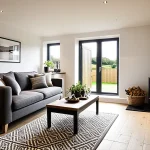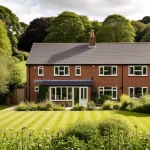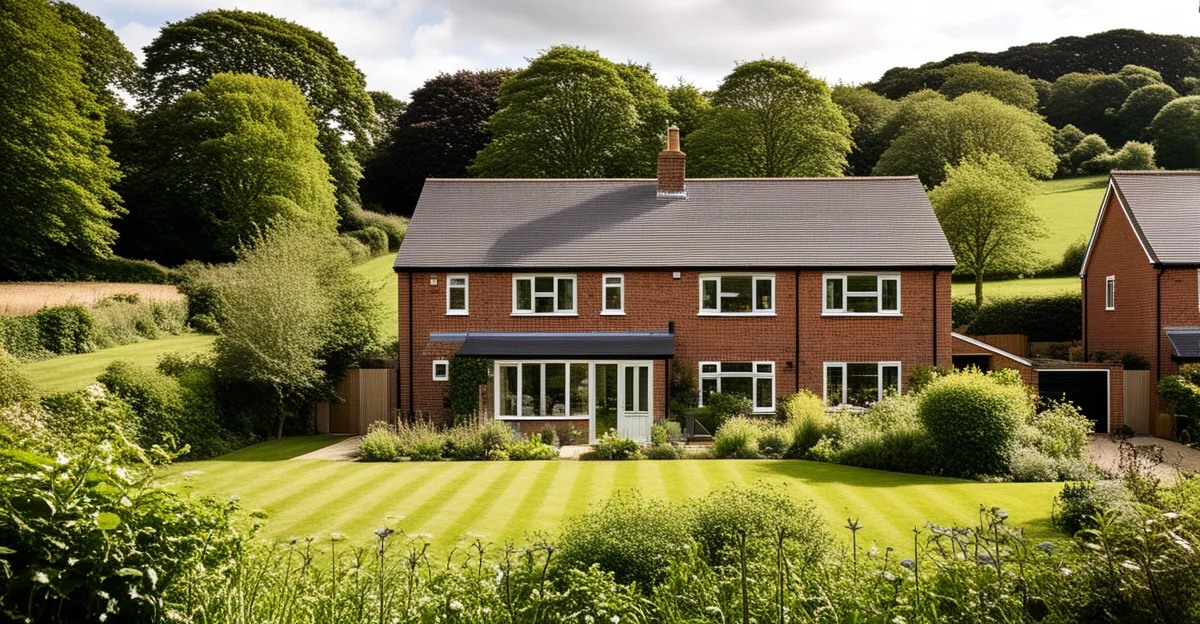Impact of Sustainable Living on UK Real Estate
Sustainable living is reshaping UK real estate by integrating eco-conscious principles into housing and property markets. At its core, sustainable living prioritizes energy efficiency, reduced waste, and minimal environmental footprint. These values align with growing demand for homes that are both environmentally responsible and economically viable.
The UK market is witnessing a clear shift toward eco-friendly homes and sustainable developments. This trend responds not only to environmental concerns but also to social and economic factors. Socially, green homes promote healthier living environments, which appeals to increasingly environmentally aware buyers. Economically, energy-efficient properties offer long-term savings on utilities and maintenance costs, enhancing their attractiveness.
In parallel : How Can the UK Real Estate Market Adapt to New Financial Regulations?
Market trends reveal increased investment in sustainable living projects. Developers are adopting materials and designs that reduce carbon emissions, while buyers seek residences compatible with low-impact lifestyles. This movement transforms the property landscape, placing sustainability at the forefront of UK real estate decisions.
Addressing environmental impact, sustainable living supports carbon reduction targets crucial for the UK’s climate goals. Consequently, property trends reflect a growing emphasis on responsible, future-proof housing, influencing choices across the market spectrum.
Additional reading : How Are Emerging Real Estate Markets Shaping UK’s Financial Landscape?
Sustainable Property Design and Construction Innovations
Sustainable living principles strongly influence green building design and eco-friendly construction in UK real estate. Developers increasingly use sustainable materials such as reclaimed wood, recycled metal, and low-impact concrete alternatives to minimize the environmental impact of new builds. These materials contribute to reduced carbon footprints and support long-term durability.
Energy efficiency is a critical focus. Modern properties integrate advanced insulation, airtight construction, and energy-saving windows to reduce heat loss. Renewable energy systems, including solar panels and heat pumps, help cut reliance on fossil fuels. Water-saving technologies like rainwater harvesting and efficient fixtures further enhance sustainability.
Industry benchmarks like BREEAM and Passivhaus certifications set high standards for energy performance and environmental responsibility. BREEAM assesses factors ranging from energy usage to indoor air quality, while Passivhaus promotes ultra-low energy consumption through rigorous design criteria.
These innovations drive the transformation of UK property trends toward sustainable developments that offer healthier, cost-effective living spaces, aligning with the increasing demand for eco-friendly homes. This shift supports both environmental goals and resident wellbeing by embedding sustainability directly into construction and design processes.
Sustainable Property Design and Construction Innovations
Sustainable living is driving significant advances in UK real estate through innovative design and construction methods. Central to these developments is the use of sustainable materials such as reclaimed timber, recycled steel, and low-carbon concrete, which reduce environmental impact from the outset. Additionally, green building design emphasizes maximizing natural light and ventilation, which lowers energy consumption and improves occupant wellbeing.
Energy efficiency is paramount; modern UK properties widely incorporate high-performance insulation, triple-glazed windows, and airtight building envelopes. These features minimize heat loss, directly addressing energy waste—a critical concern in sustainable living. Renewable energy systems, particularly solar panels and ground-source heat pumps, are becoming standard, enabling homes to generate their own clean energy and lower utility costs.
Water-saving technologies like rainwater harvesting and low-flow fixtures further reduce resource use, reinforcing sustainable principles. This holistic approach to eco-friendly construction also aligns with industry certifications such as BREEAM and Passivhaus. These benchmarks rigorously assess environmental performance, encouraging builders to meet strict standards and boosting buyer confidence in sustainable properties.
Together, these innovations transform property trends, embedding sustainability deeply within the fabric of UK real estate and supporting the drive for a greener future.
Regulatory Frameworks and Government Incentives for Sustainable Real Estate
The UK government has established a comprehensive set of property regulations to drive sustainable development in real estate. Central to these is the Future Homes Standard, aiming to ensure new builds achieve near-zero carbon emissions by 2025. This policy mandates enhanced energy efficiency, promoting the adoption of eco-friendly construction methods and materials.
Financial incentives accompany regulation to encourage compliance. Homeowners and developers can access grants and subsidies for installing renewable energy systems such as solar panels and heat pumps. These government incentives reduce upfront costs, making sustainable projects more economically viable and accelerating market shifts toward greener housing.
Regulations also impact refurbishment projects, requiring improved insulation and energy-saving upgrades that align with national carbon reduction goals. Compliance with standards like BREEAM benefits from governmental support, positioning certified properties favorably within UK real estate.
Together, these frameworks and incentives stimulate innovation and investment in sustainable housing. They effectively reshape property trends, embedding environmental responsibility into the fabric of the UK market while providing tangible economic advantages for stakeholders embracing sustainable living.
Regulatory Frameworks and Government Incentives for Sustainable Real Estate
Government policies and UK property regulations play a pivotal role in shaping the sustainable living landscape within real estate. The Future Homes Standard is a landmark regulation aiming to ensure all new homes produce significantly lower carbon emissions by 2025. This mandates energy-efficient design and the integration of renewable technologies, pushing the industry toward widespread eco-friendly construction.
Financial incentives include grants and low-interest loans that encourage developers and homeowners to adopt sustainable development practices. Schemes like the Green Homes Grant have previously supported insulation upgrades and renewable installations, illustrating how government incentives can accelerate eco-friendly property trends.
Regulatory frameworks also impose stricter requirements on building materials, waste reduction, and water efficiency, ensuring compliance with environmental goals. Together, these policies reduce the environmental impact of new and existing housing stock, making sustainable living a practical and attractive option.
The influence of these regulations and incentives extends beyond compliance; they foster innovation by setting benchmarks that developers strive to exceed. This alignment of policy and market forces drives the evolution of UK real estate, promoting healthy, energy-efficient homes that meet both consumer demand and climate objectives.
Economic and Investment Considerations for Sustainable Properties
Sustainable properties offer notable financial advantages for both homeowners and investors within the UK real estate market. Energy-efficient homes reduce utility bills significantly, providing immediate cost savings. Over time, these cost reductions contribute to substantial economic benefits, enhancing the appeal of sustainable living investments.
How do sustainable homes impact market value? Research shows eco-friendly properties often command a premium price compared to conventional homes. Buyers increasingly seek residences with lower running costs and improved environmental credentials, driving up demand. This demand supports stronger resale values and stability in fluctuating markets.
Property investment in sustainable real estate also carries long-term benefits. Green buildings typically require less maintenance due to durable, sustainable materials and superior construction practices such as advanced insulation and energy systems. This results in lower upkeep expenses and increased asset longevity.
Moreover, sustainable homes demonstrate greater resilience amid changing regulations and rising energy costs, effectively future-proofing investments. Market trends confirm a growing preference for properties aligned with climate-conscious living, positioning sustainable real estate as a practical, economically sound choice for current and future homeowners.
Impact of Sustainable Living on UK Real Estate
Sustainable living centers on reducing environmental impact, conserving resources, and promoting wellbeing. In the context of UK real estate, this means designing and purchasing properties that minimize carbon emissions, utilize renewable energy, and support healthier living spaces.
The shift toward eco-friendly homes reflects growing consumer awareness of environmental and social issues. Buyers increasingly prioritize energy efficiency, reduced waste, and green amenities, fueling new property trends. Developers respond by incorporating sustainable features such as efficient heating systems, better insulation, and locally sourced materials.
Environmental impact is a major driver in the transformation of UK property markets. Properties with lower emissions meet national targets and often qualify for incentives. Social benefits include healthier indoor air quality and improved community green spaces, enhancing resident wellbeing. Economically, sustainable homes typically reduce utility costs and maintain higher resale value, attracting both homeowners and investors.
These combined factors accelerate market-wide adoption of sustainable living principles, embedding them into housing demand and construction practices. The evolving UK real estate landscape shows clear momentum toward environmentally responsible and socially conscious property choices.
Impact of Sustainable Living on UK Real Estate
Sustainable living focuses on reducing the environmental impact by promoting energy efficiency, resource conservation, and healthier lifestyles. In the context of UK real estate, this means housing developments prioritize low carbon emissions, renewable energy use, and eco-friendly materials. These principles guide property markets, shaping current property trends toward greener homes.
The market shift toward sustainable living is driven by three main factors: environmental, social, and economic. Environmentally, demand grows for homes that support national carbon reduction targets and improve air quality. Socially, buyers prioritize living spaces that foster wellbeing through natural lighting, improved ventilation, and reduced pollutants. Economically, energy-efficient homes offer lower utility bills and higher resale values, making them attractive investments.
These influences collectively push UK developers to integrate sustainable features like advanced insulation, renewable energy systems, and sustainable materials into property design and construction. As consumer preference shifts, property trends increasingly favor developments with certified eco-credentials. This progress reinforces sustainability’s role in transforming the UK real estate landscape into one that supports long-term environmental goals while meeting buyer expectations.
Impact of Sustainable Living on UK Real Estate
Short exploration of evolving market dynamics
Sustainable living fundamentally reshapes UK real estate by embedding environmental consciousness into property development and demand. Its core principles—energy efficiency, resource conservation, and reduced carbon footprint—drive significant shifts in property trends. Today, eco-friendly homes increasingly dominate buyer preferences, reflecting a heightened awareness of climate change and sustainable lifestyles.
Market evolution toward sustainable living is propelled by intertwined environmental, social, and economic factors. Environmentally, properties that reduce emissions align with national climate targets and lessen the environmental impact of housing stock. Socially, greener homes offer healthier indoor environments through improved air quality and natural lighting, positively influencing resident wellbeing. Economically, such properties reduce energy costs and often retain higher resale values, making them attractive investments in a competitive UK housing market.
This demand compels developers to integrate sustainable features—such as renewable energy systems, advanced insulation, and green building materials—fostering a property landscape where sustainability is central. The resulting transformation not only supports environmental goals but also caters to evolving consumer expectations, confirming sustainable living as a pivotal force in shaping the present and future of UK real estate.









